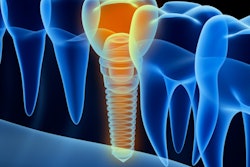
Aluminum foil has its place in the kitchen, but did you know it comes in handy in the dental practice as well? Foil can be used to facilitate open-tray dental implant impressions, according to an article published on July 1 in the Journal of Prosthetic Dentistry.
The use of standard household 0.016-mm aluminum foil simplifies the procedure and acts as an adequate temporary sealing when dental impression material is loaded, the authors wrote.
"The aluminum foil is sufficiently rigid to hold the impression material in the tray while being easily penetrated by the open-tray impression copings," wrote the authors, Drs. Fang-Yu Su and Aaron Segal from Temple University Kornberg School of Dentistry in Philadelphia.
When clinicians choose to use the conventional impression method over digital optical scanning for patients who have at least four dental implants, it is recommended that they take an impression using an open tray. An open tray has a large opening to accommodate a patient's complete-arch impression copings. However, the large opening makes it difficult to keep the impression material from running off while it is loaded on the tray, the authors noted.
Over the years, clinicians have used wax tray closures or plastic sheets with self-perforated trays to temporarily seal the opening and prevent the material from escaping. Both have proved to be less than perfect solutions. The wax tray can be messy, and the abutment screw does not always penetrate the wax, ultimately affecting the accuracy of the impression, they wrote.
5-step foil technique
The researchers suggested the following steps to improve and simplify the open-tray process:
- Create a personalized impression that contains holes that are big enough to accommodate the impression copings.
- Place the tray in the patient's mouth and evaluate how it looks with the splinted impression copings in place. Make appropriate changes to ensure the copings extend beyond the tray.
- Apply tray adhesive and apply standard household aluminum foil from the tray's impression surface to cover the hole. Then, add another layer of adhesive over the aluminum foil.
- Load the impression material to fill the tray.
- Make a dental impression. The copings automatically will puncture the aluminum foil.
Using the described aluminum foil technique provides adequate temporary sealing during material loading and allows the operator to easily "see the impression copings and find the screws at the time of the impression removal," Su and Segal concluded.



















